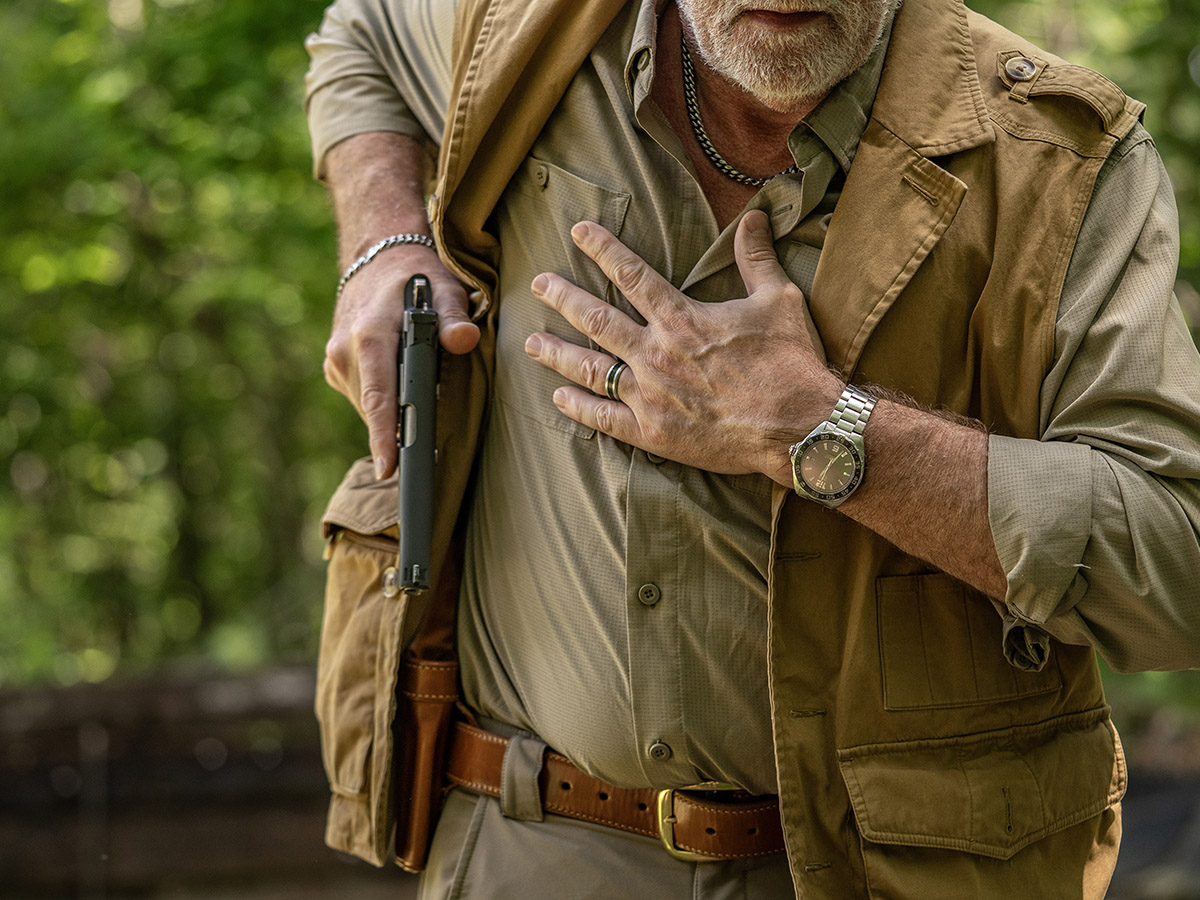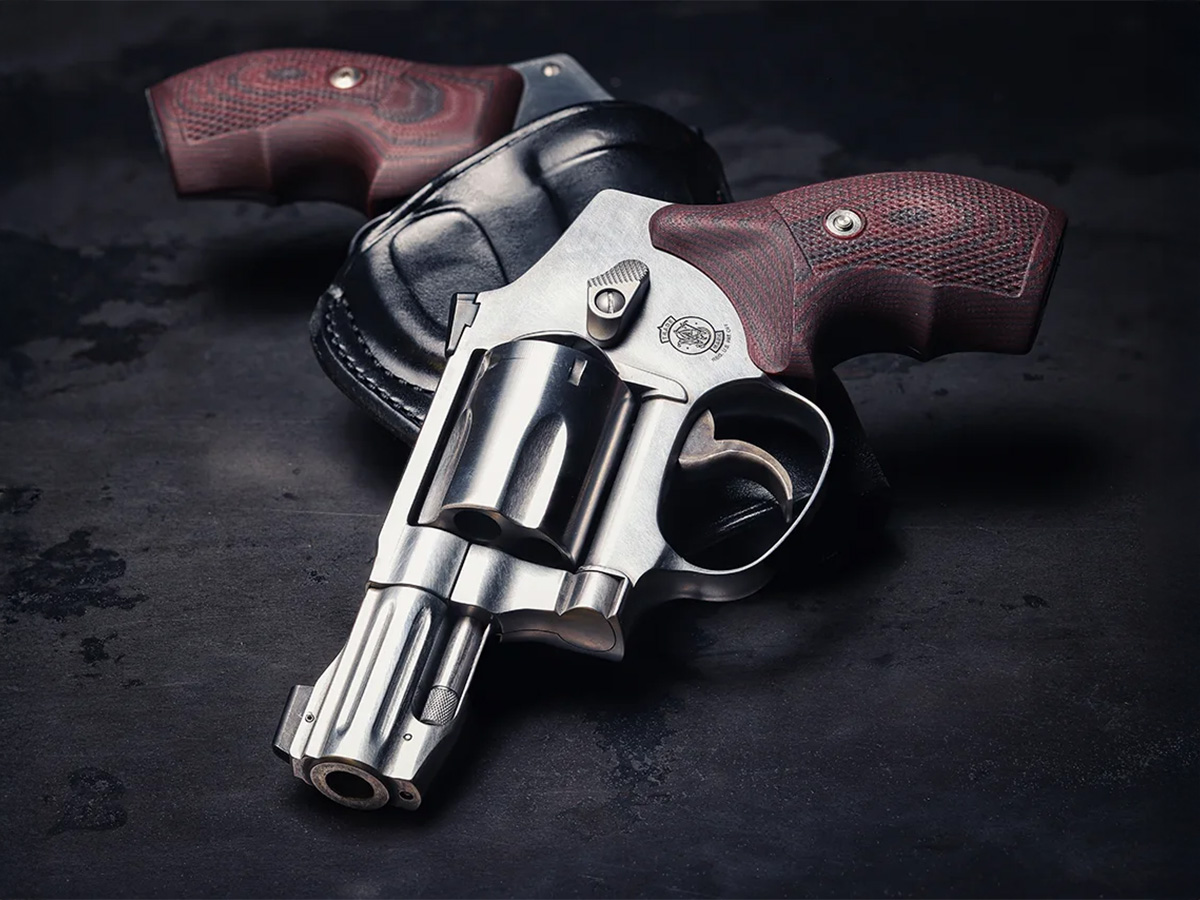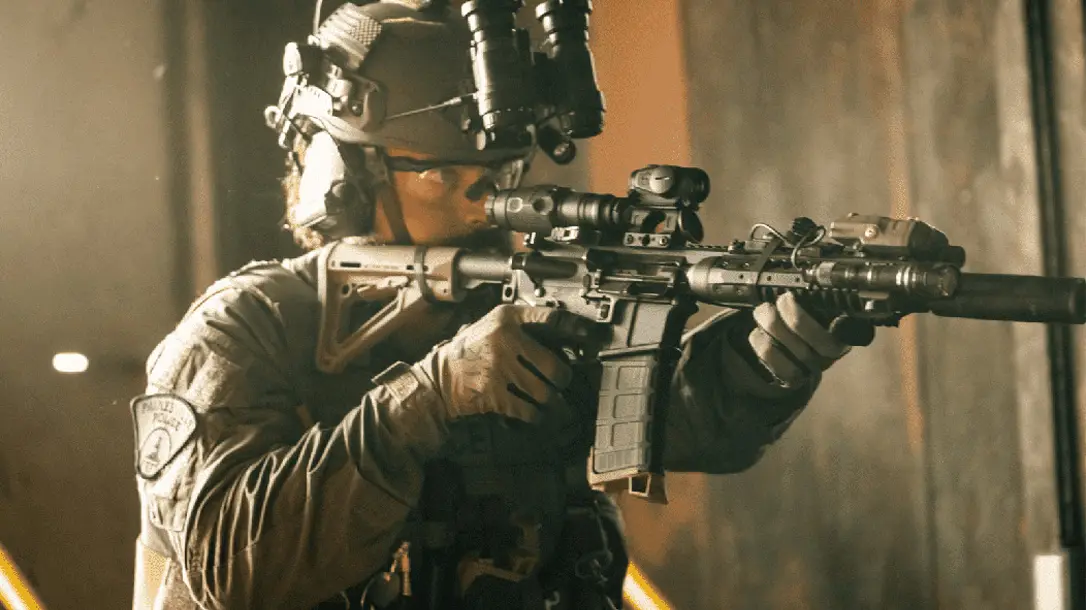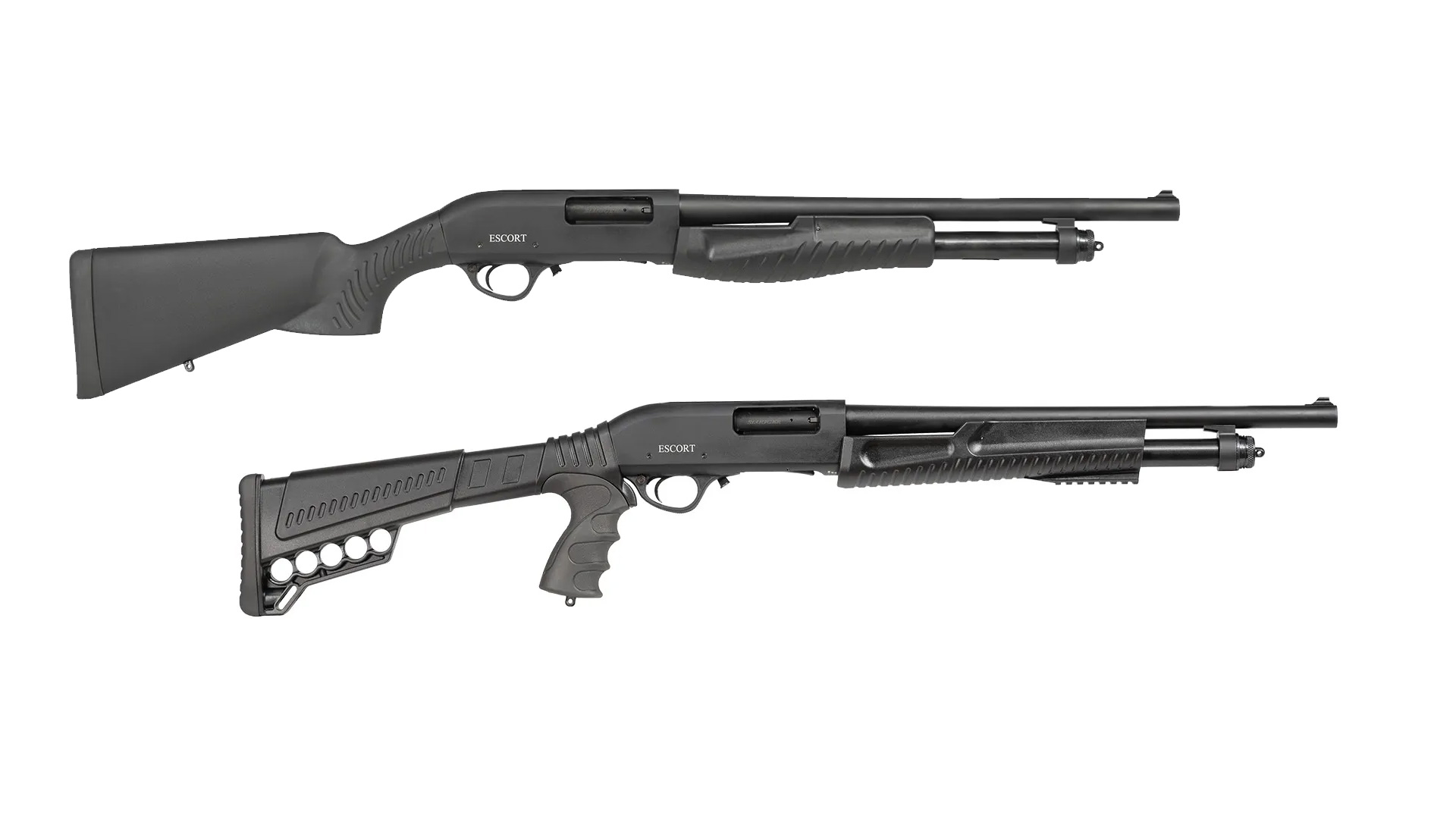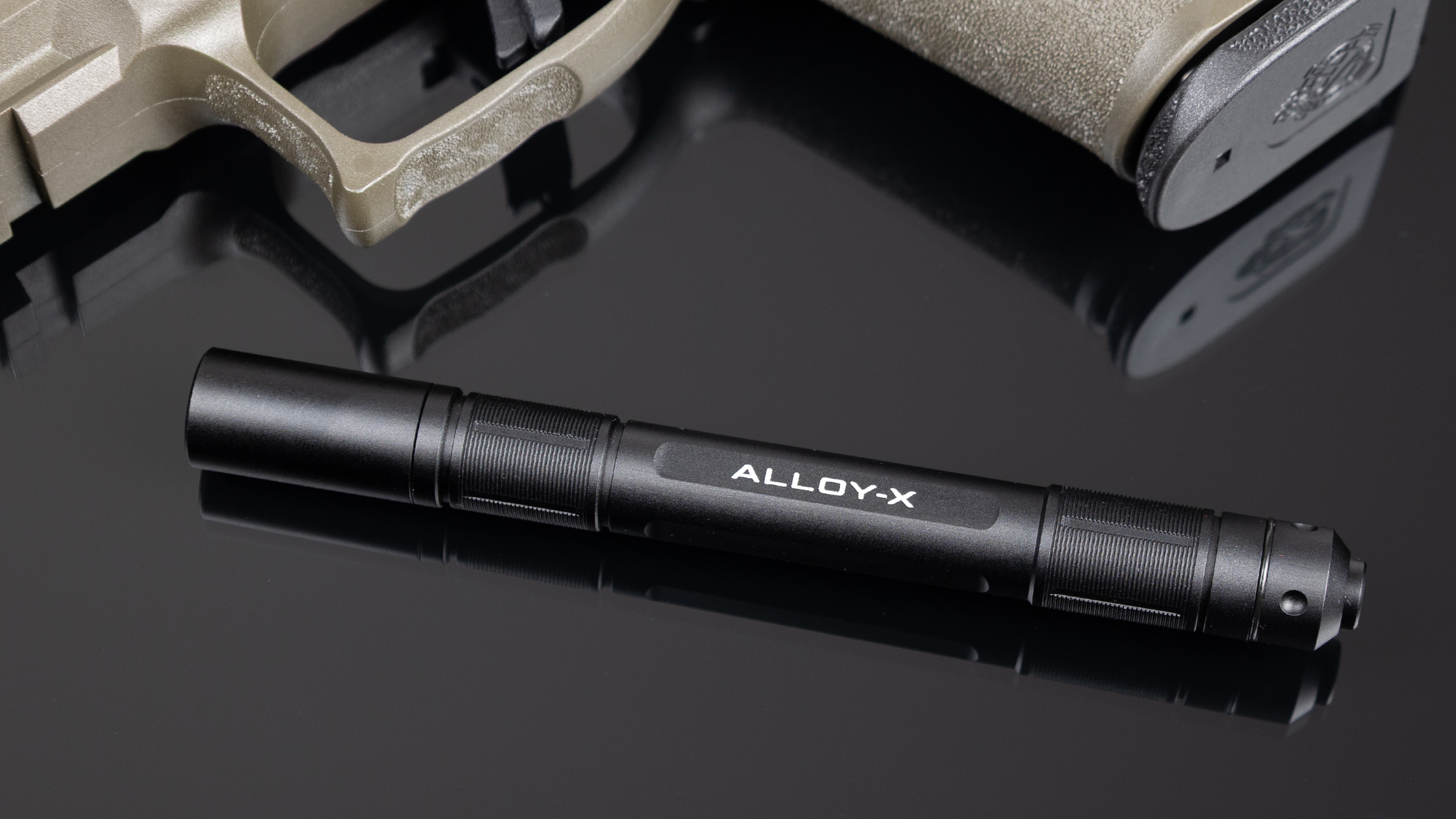A Holster For Every Occasion
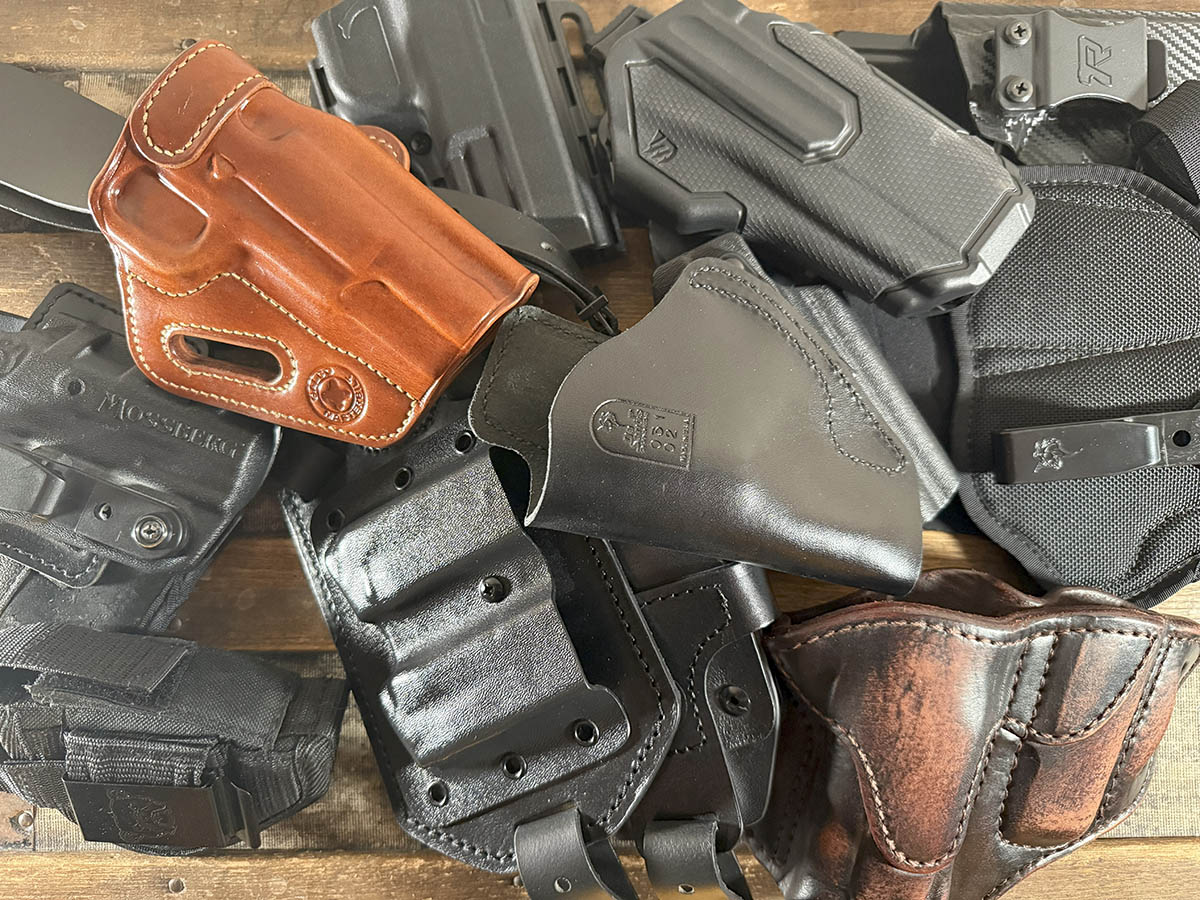
No single holster can cover everything. Different situations, seasons, and attire call for flexible concealment options.
Thanks to the relaxation of concealed carry laws nationwide, more Americans than ever are carrying firearms as part of their daily lives. You could argue that the concealed carry culture is still in its infancy as, unlike hunting, it was not part of our prior generation’s reality in much of the country. Where a hunter may have had a father, grandfather, uncles, neighbors or friends with strong feelings about camo, calibers, optics, or ammunition accrued over several generations of experience, concealed carry still lives in its first or second generation of experimentation.
I was new to it myself, and something I struggled with was holster selection. I see many other carriers struggle to find a single holster that provides the perfect solution for every situation. Like the fabled one true ring of the Tolkien epics, this holster is the missing piece to a successful outcome for whosoever is lucky enough to wield it.
But like Tolkien’s tale of Middle Earth, this holster is fantasy.
Seasons, attire, and situations present unique challenges that you must consider when deciding how to approach your day with a concealed firearm. That means you must be flexible in your holster choices and less dogmatic about how you carry your firearm. Rather than encountering a situation that prevents you from carrying because your singular holster option can’t account for what the day presents, you need a suite of carry options that allow you to adapt your daily carry to the specific needs.
You may be struggling to choose one holster and see the prospect of choosing more than one as a multiplicative problem that appears even more daunting than the original quest. I assure you this isn’t the case. By evaluating several contributing factors, considering the reality of situations in which you would carry your gun, and identifying the two or three options that work for you, finding the best solution is quite simple.
Your Carry Gun
The first reality is that your chosen gun will determine the number of options you have for a carry holster. A 4-inch-barrel 44 Magnum is as poor a choice for pocket carry as a single-stack 380 Auto is for a shoulder holster. Few options are off the table, but that doesn’t mean that they won’t have a longer list of negatives than positives.
Also, consider holster and gun rotation—a concept that has gained too much traction. It’s one thing to have a primary carry gun and a backup that can serve as an alternate. There may also be limited call for those who carry to less-permissive states to have a travel gun, like a 38 Special snubby that doesn’t face the magazine restrictions of more progressive states. That said, I struggle with folks who have four or five guns that are carried seemingly at random just for the sake of rotation. Most of us don’t shoot or train enough as it is with our primary gun.
You can do as you please. I’m not here to finger-wag anyone for their choice of what to carry. That said, carrying a defensive firearm is something that shouldn’t be done flippantly or with fashion or popularity as the primary decision-maker over proficiency or skill.
Holster Location
The location on your body you choose to carry will be the primary factor in determining which holster you select, as most designs are specifically tailored to it. Carry location fits into one of two categories: traditional or non-traditional. Traditional locations are on the beltline, either inside or outside of the waistband. Typically, the holster is positioned on the hip of the strong side. I also placed appendix carry in this category, and we’ll discuss why later.
Non-traditional locations include things like shoulder or pocket holsters or even off-body carry.
As a baseline, it’s wise to have a holster from each category—traditional and non-traditional—to cover as many circumstances as possible.
Traditional
Outside the Waistband (OWB)–Strong Side


There’s a little bit of John Wayne to outside-the-waistband carry. Contrary to popular belief, just because it’s outside the waistband doesn’t mean it’s an open-carry, cowboy-wannabe position. A cover garment such as a lightweight shirt, jacket, or vest can conceal an OWB holster and pistol.
While it may print more easily against the cover garment than something concealed more deeply, it is a viable solution when a suitable cover garment is available.
The biggest benefit to OWB carry is accessibility. Because it isn’t as concealed as it is deep, it can be easier to access. This also makes for a more comfortable carry. Carrying a gun is not a fun, comfortable, or enjoyable endeavor. As Clint Smith said, “Guns are supposed to be comforting, not comfortable.” OWB keeps the firearm from digging into your hip, making for an enjoyable experience.
That said, it is tougher to conceal because the handgun’s profile is outside the beltline. This can present a more “bolted-on” appearance to your silhouette and makes it easier for bystanders to see that you are packing. In some instances, this may not be a big deal, but if you’re in a state where no-firearm signs carry the force of law, it may be unwise.
Some guns demand to be carried outside the waistband in a classic leather holster. While I’m no 1911 romantic, I cringe when I see one holstered in anything but leather outside the waistband. For my Springfield Armory 1911 Operator, 1791 GunLeather provided the best solution. It just looks and feels right.
Inside the Waistband (IWB)–Strong Side
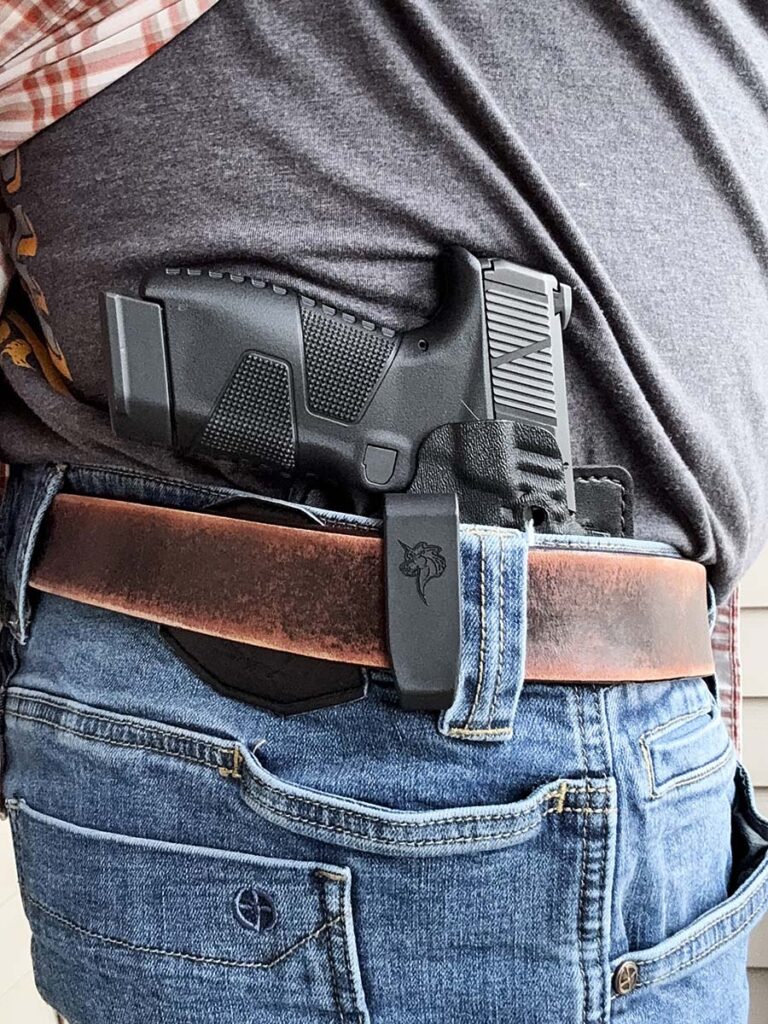

For many years, inside-the-waistband carry on the strong side has been the gold standard. Hiding your handgun inside the waistband coupled with the natural reach and draw of the strong side makes for a solid balance between concealment and accessibility. Virtually every carry gun has had someone produce an IWB holster for it.
While not as comfortable as OWB carry, it’s out of the way enough so that comfort isn’t an issue while sitting, standing, or walking. It’s also less likely to print than OWB carry because the holster’s position inside the waistband keeps everything pulled in tighter to your body.
Another factor to consider is the extensive amount of training and resources available for IWB concealed carry. Volumes of books have been written on the subject, and almost every reputable trainer is well-versed in getting students to work from an IWB strong-side position.
Inside the Waistband–Appendix
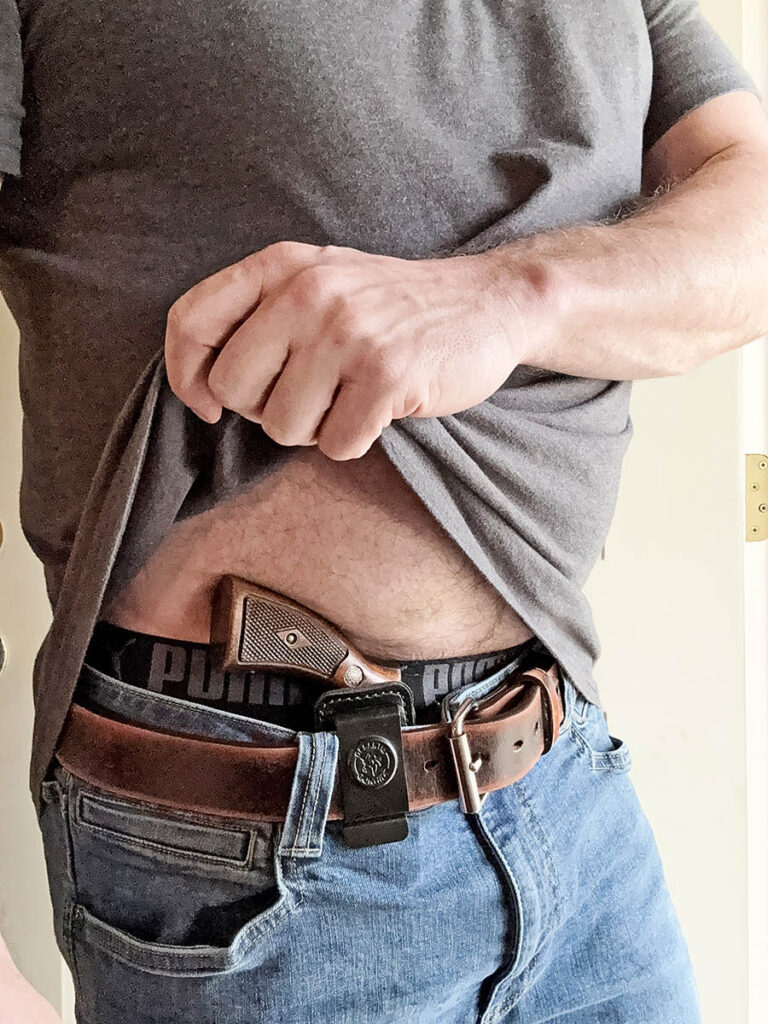

Not that long ago, so-called appendix carry would have been considered a non-traditional holster location. Because the concealed carry culture is still in its early phases, and so many shooters are working on solutions to problems, appendix carry has emerged as probably the second-most popular carry location.
For those unfamiliar, appendix carry places the holster in front of the hip in the 12:30 to 1:30 position, with the muzzle aligned down the inside of the strong-side leg. The rapid growth in popularity, the massive expansion of appendix holster options, and the location of the holster on the beltline make the case for it being considered a traditional carry location.
There’s also the explosion of sub- and micro-compact EDC pistols as part of the appendix carry boom. As mentioned, your carry gun determines the holster and carry method. The appendix style is not one for full-size semi-auto pistols or full-frame revolvers. The proliferation of the SIG P365, Smith & Wesson Bodyguard, Springfield Hellcat, and others have opened the door to the growing popularity of this style.
There is a lot to like about the appendix position. It can be a remarkably comfortable position to carry, especially when you are on your feet and walking around. Concealment is also quite good, depending on the cut of your clothing, and it can be accomplished without a cover garment other than your shirt, provided it isn’t tucked in.
“In concealed carry, we’re seeing a mild trend away from appendix carry and back toward strong-side hip positioning,” said Mike Barham, Media and PR Manager at Galco Holsters. “I think this is for both comfort and some tactical reasons that weren’t fully explored properly.”
On its face, this logic makes sense. While everyone is looking for the easy button, the popularity of appendix carry offered some of the tactical advantages outlined earlier and we saw people gravitate to a carry position that allowed them to run faster times against a standard; others saw a benefit in the position.
Perhaps the most compelling benefit is the firearm’s accessibility from the front of the body. A simple lift of the shirt with the support hand exposes the grip, making the purchase quick with minimal effort, even for individuals more accustomed to strong-side carry. A timer can reveal marked improvement in how quickly you can enter the fight.
Those comfort and concealment positives, though, are somewhat reliant on the cut of your jib. For those of us who pack a little more around the middle than others, this position can be more challenging. A protruding belly can exert constant, uncomfortable pressure, and depending on the specific geometry of your body, it may also result in a pistol that is tilted out and shows. Provided you have a chest that extends beyond your belly button, either due to biology or muscle mass, appendix carry can be a good option. If not, it may just not be a good fit.
Non-Traditional
Shoulder Carry
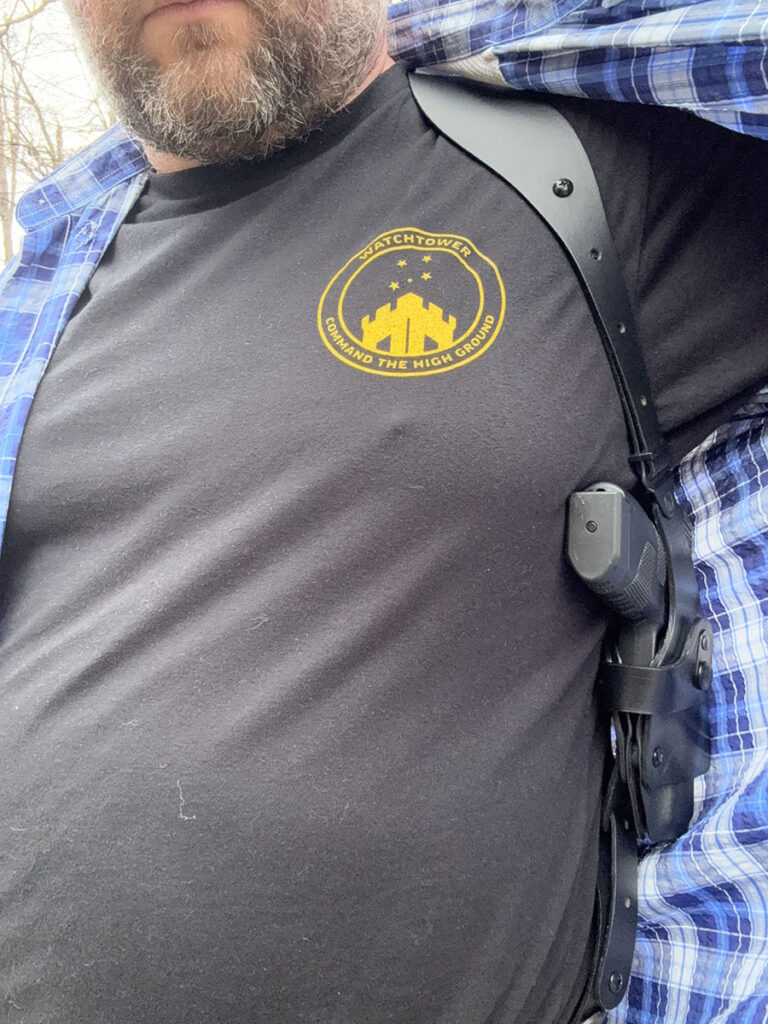

I used to think I needed to have a decade on the beat and a handful of years behind a desk as a detective before I could apply to a holster manufacturer for a shoulder model. I’m just old enough to remember the Galco-supplied shoulder holsters on Miami Vice, and I thought they were only for cops.
As with everything else, fewer carry restrictions mean more carry options, and holster makers have added some refinement to the shoulder holster lineup. I find shoulder holster carry to be the most comfortable. Because the weight of the firearm is carried by the yoke on your shoulder rather than on the beltline, that bother is eliminated. Further, the gap between your armpit and upper arm is purely wasted space on the human body, so being tucked into that location bothers nothing.
On a day when I know I will be behind the wheel of my truck more often than walking, carrying a concealed handgun in a shoulder holster is my preferred solution. Because in the seated position, getting to the beltline can be a problem, a shoulder location is easily accessible without needing to remove the gun from my person. For driving, shoulder carry is my A+ answer.
Shoulder carry is not without its drawbacks, however. It can be a tougher location to access and draw from safely. Many shoulder holsters carry the firearm in a horizontal position, making it easy to flag bystanders or even your support arm if careful skill in drawing is not developed. While a great option with a jacket, vest, or overshirt, a hooded sweatshirt (a favorite garment of mine) presents real difficulty in getting the gun into the fight quickly and cleanly.
Overall, I believe shoulder holsters are significantly underutilized as a viable carry option, especially for those of us in northern latitudes where jackets and vests are a staple of our attire for much of the year.
Galco has recently introduced the Masterbilt Slabside Perfection Shoulder System. With the pistol placed on the weak side and two magazines on the strong side, you can easily carry more than most find comfortable on their beltline.
I have also become a fan of the Falco Hybrid Roto Shoulder Holster, which features a double mag pouch. The hybrid design uses a Kydex holster and leather strap system for the best of both worlds. Additionally, the holster features a snap that maintains its vertical orientation when worn, keeping the barrel pointed downward. You can draw from this position or release the snap, and the Kydex will rotate 70 degrees towards the horizontal for a cleaner drawstroke. The double mag pouch is also Kydex.
Pocket Carry
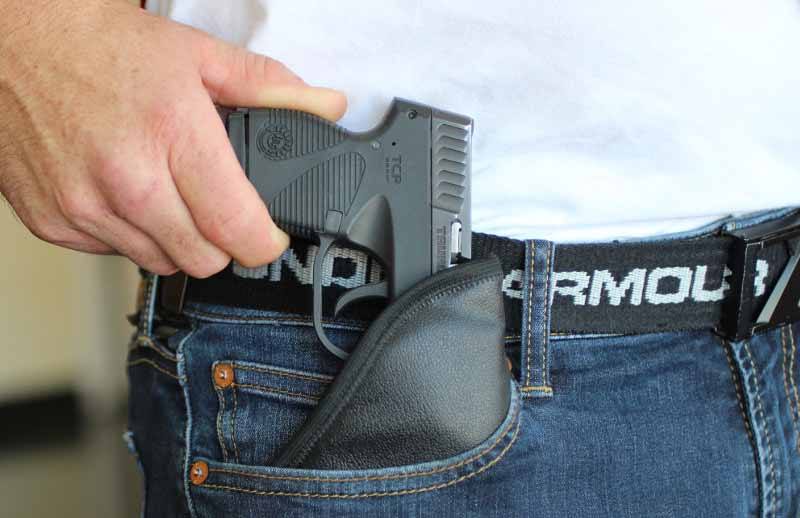

What about just sliding one of those subcompact pistols into your pocket and calling it a day? While it isn’t quite that easy, it isn’t far off, either. Pocket holsters are little more than a sleeve for a small pistol or revolver with a tacky or grippy exterior that allows you to reach into your pocket, grip the firearm, and draw it while leaving the holster in the pocket.
When I was working in sales, this became my best option for carrying a firearm. Because my job often called for dress slacks and polos, I had few places to conceal a firearm. A subcompact 9mm appeared to be little more than a BlackBerry in my pocket, and never once did anyone question if that was a giant phone in my pocket or if I was just happy to see them.
Chalk the biggest appeal here up to convenience. What can be simpler than putting a gun in your pocket? The materials have become quite reliable over the years, and when attire calls for it, pocket holsters are a superb option. However, despite having done it for a long time, it never felt as secure as I would have liked it to. We’ve all experienced sitting in an awkward position or leaning over to get something and having the contents of our pockets end up on the sidewalk or meeting room floor. I would prefer that not happen with my EDC pistol.
Off-Body Carry
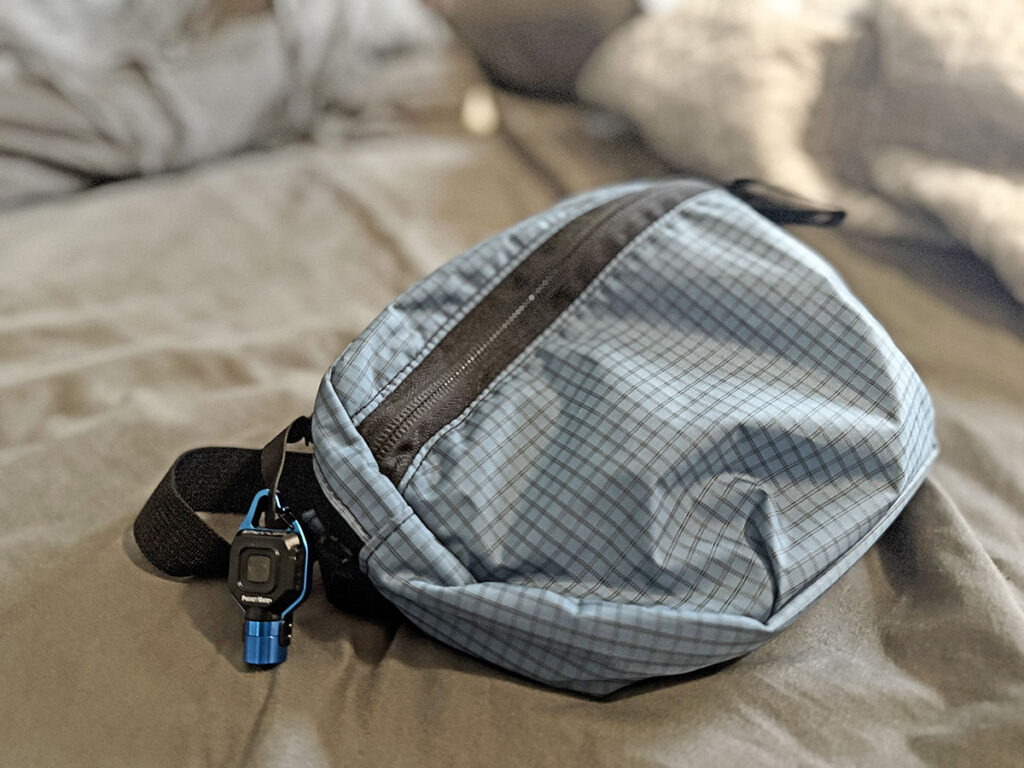

An explosion of purses designed for women who carry has popularized off-body carry. For men, there is the option of a fanny pack. Initially, I turned my nose up at the prospect of using one, but after paying attention while out in public, I was surprised to see fanny packs in use far more often than I had thought.
I started testing it out mainly to try to poke holes in the endeavor, as I’ve never been a big fan of it. That said, there are days when I want to run errands in athletic shorts and a hoodie—the unofficial uniform of spring and fall in the Midwest—and carrying that outfit leaves you with precious few options.
Slinging a fanny pack over your shoulder doesn’t look out of place among other folks who are doing the same thing at the local farmer’s market. Also, I can carry significantly more stuff in my fanny pack. There’s easily room for a reload or two, a couple of tourniquets, basic first aid items, a light, a knife, wallet, keys, and a snack.
The appeal of off-body carry is undeniable, and I’ve found myself defaulting to it more often due to its comfort and ease. Most CCW fanny packs have a dedicated handgun pocket, allowing you to separate your EDC (Everyday Carry) items from other things. No fumbling through pockets or loading up the beltline. It’s something to consider if you’ve been undecided.
That said, like every other option, it has downsides. The one I’ve struggled with the most is working on a new drawstroke. Like clearing a cover garment, you need a swift motion to get the pack open enough to access the firearm. This difficulty varies significantly from one pack to another and from one orientation to another. There is no simple solution that applies to every situation.
Most fanny packs have a tab to pull that opens the carry compartment quickly. Most, not all. Noted trainer Greg Ellifritz has found that the pull tabs are often too small to locate and use reliably, especially during the stress of a defensive engagement. His trick? Add a small flashlight, such as a Streamlight Pocket Mate, to the tab to improve the purchase. Not to mention, having an extra light is never a bad thing. I’ve adopted this logic to my setup.
Depending on how you orient the bag, you may also encounter a situation where the gun is pointed at those around you, and your drawstroke may exacerbate this, similar to a shoulder holster. It’s not a deal-breaker, but it’s another consideration.
I’ve become a fan of the Ex Umbris Designs UltraGrid Multifunctional Fanny Pack. It uses a Velcro panel in the main pouch to secure a holster of your choice. This design allows for the holster to be adjusted to the draw angle that works best for you, while some others use Malice Clips that don’t offer quite the same level of flexibility.
The DeSantis Gunny Sack II and Vertx Everyday Fanny Pack 2.0 are also popular options for carriers.
Of course, there are also purses available for off-body carry from brands like Browning and Gun Tote’n Mamas, which allow for something a little more stylish for the ladies who carry.
Ankle Carry
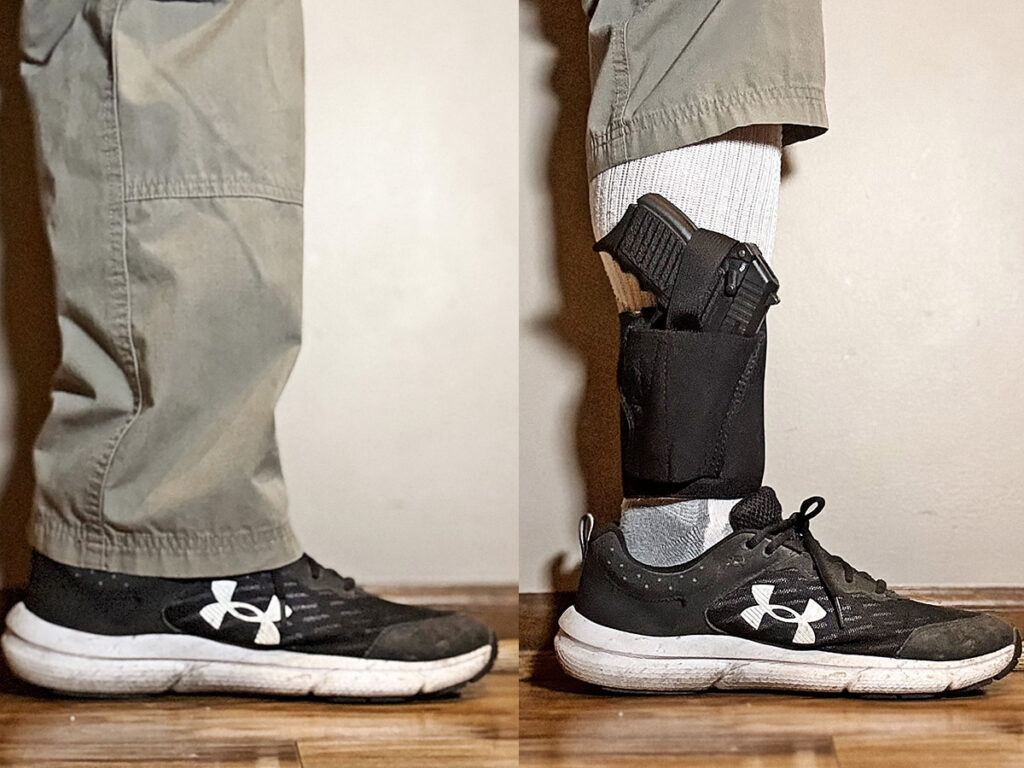

I saved ankle carry for last because I don’t think it should ever be the location of your primary firearm. While drawing a firearm from all the other locations listed above can be done naturally under duress and without compromising your situational awareness, drawing from your ankle requires you to bend over or crouch to access your firearm.
Are there situations where ankle carry is your only option? I suppose that’s possible, but I consider it for backup only. The idea of a snub-nosed 38 Special on the ankle has almost become a grizzled-cop trope, but with some reason. A fair number of cops I’ve talked to have done precisely that and continued to do so even when they were off-duty or retired.
I’ve experimented with the Apache Ankle Rig from DeSantis. When I was a young salesman out on the road in some rough neighborhoods of Northwest Indiana, a Sccy CPX-1 was my everyday carry gun. While I’ve retired it, it fits the bill of a backup gun and plays well with such a configuration.
Ankle carry is not something I do regularly, but it’s nice to have another option. An ankle setup is also a viable way to carry a snub-nose revolver. With today’s revolver renaissance, it might not be crazy to have ankle carry as an option, just not as a primary solution.
However, as with all the positions we outlined, there are also downsides, and as more people adopt a carry style, there is increased scrutiny surrounding it. What works for one person may not work for another, and those preferences as choices may change over time.
Holster Material
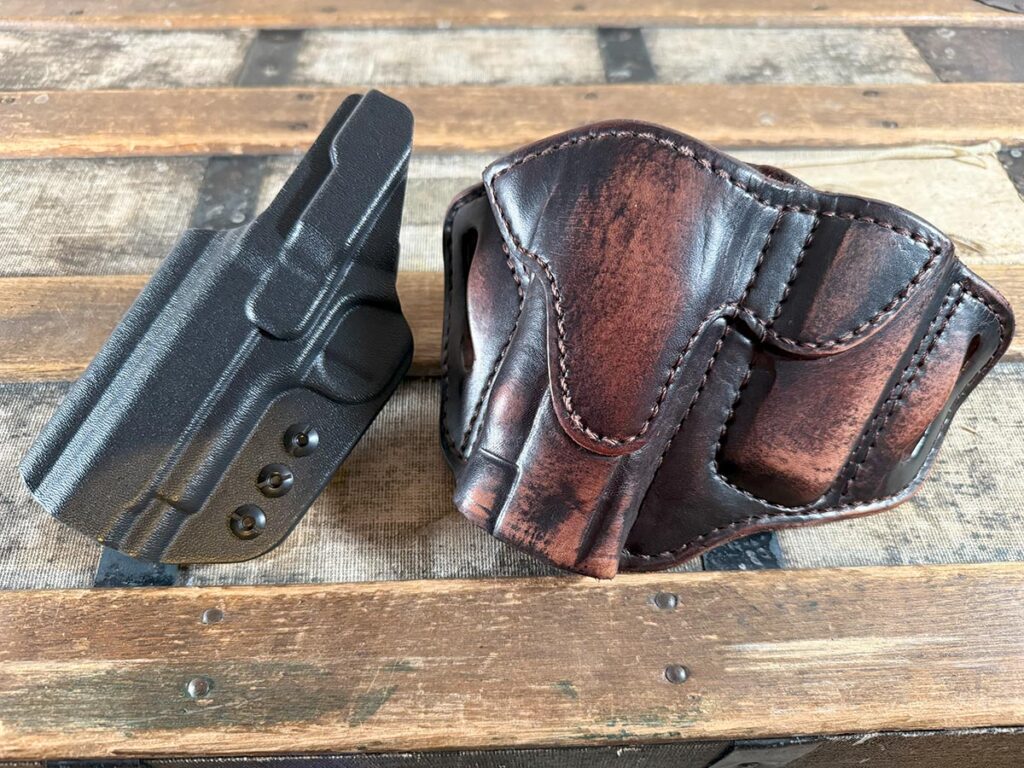

No matter which of the above positions you choose to carry, your holster has to be made of something. Each material has pros and cons, just like the carry positions.
The most traditional holster material is leather. Leather evokes images of gunfighters from the Old West, such as Buffalo Bill Cody, Bat Masterson, Wyatt Earp, or the men who portrayed romanticized versions of them.
Leather still has a place in the EDC world, even if newer materials have encroached on what was once a single-material market. Leather options remain popular for revolvers, whose lines create an uncomfortable angle in a more rigid material. Also, as a natural material, it has a warmth that other materials don’t. Leather can soften the edges of a cylinder, making it easier to conceal in a beltline.
Leather is bulkier than other options, however, and can be harder to conceal based on your gun’s profile. Aside from the actual friction of the gun on the leather, any retention mechanism must be done with a snap or Velcro.
Kydex has become the dominant holster material. There are numerous benefits to it. From a manufacturing standpoint, it’s easier to source and produce. A Kydex mold of a specific firearm can be created, ensuring a perfect fit. Furthermore, unlike leather, adjustable tension can provide passive retention on the gun, keeping it in the holster more securely than in some leather designs.
Similarly, it’s easier to create variations of each model with accessories, such as weapons-mounted lights or cutouts for optics. Do you carry a Walther PDP with a Streamlight TLR-7? You’re far more likely to find a Kydex option than leather.
Downsides? Kydex isn’t as forgiving as leather, and it lacks the visual appeal of leather. Yes, Kydex can be customized or have patterns added, but at the end of the day, it’s still a synthetic material. Because it’s more rigid, sharp edges can lead to uncomfortable pinches when carrying.
All that said, there’s a reason Kydex has become so popular. It’s secure and reliable.
Then there’s nylon holsters, which I have regularly used. Mine is an Uncle Mike’s shoulder holster that holds a Heritage single-action .22 I carry on the trapline every winter.
It’s not that there isn’t a place for nylon in EDC holster concepts, but rather as a secondary material, such as a Velcro strap on an ankle holster, rather than the entire holster. Nylon lacks sufficient retention on the firearm while moving around unless it is snapped securely.
There are cases where a nylon design may be useful, but I think most people place it as a distant third option for holster selection.
Concealed Carry Belts
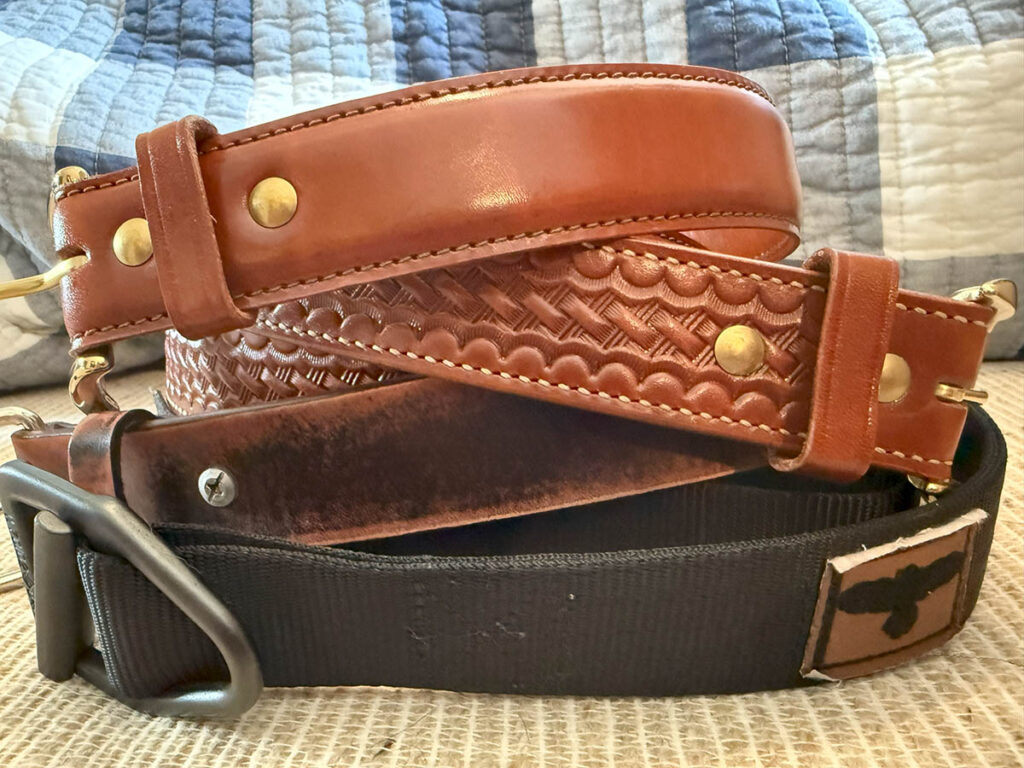

A holster is only as good as the belt that supports it. This sounds like hyperbole, but anyone who has tried to carry on a substandard belt knows it’s true. Like holsters, just one belt suitable for carry won’t do. I have nylon options from Wilderness in multiple colors to match various dress, and a casual rustic finish leather option from 1791 GunLeather that works with almost anything. I also have a couple of high-polish tan belts from Galco, one smooth and one tooled, for when I want to look a little more refined.
The common thread is that all of these belts are designed for carrying firearms. If you’ve put off the investment in a good EDC belt, I can’t implore you enough to commit to a higher-quality one. It’s a game-changing experience when your belt locks the holster in place, allowing you to make a clean draw.
Best Practices
When it comes to concealed carry holsters, no one answer works for everyone. We often learn from others’ mistakes, but what doesn’t work for someone else when it comes to holsters may be our best solution.
Choosing a holster is a process. It requires exploration and experimentation. Chances are, the first holster you try will not end up being your favorite. There’s also a good chance that the carry position you first try won’t be your preferred option. Too many people experiment too little with different holsters and location options.
“While I don’t think training should be legally mandated for concealed carriers, lots of people just don’t know what they don’t know, said Barham. “Some classroom time with a knowledgeable CCW instructor, exposure to different concealed carry methods, and some range time goes a very long way to learning what does and doesn’t work for you, and everyone is different.”
This reality is sad enough when you consider many people’s primary holster selection. The fact that so many don’t even have a second or third option for carry style makes it even more baffling.
My primary carry position will always be on the hip of my strong side. It’s the best option for me. Regardless of the handgun, I will have an IWB holster that will cover most of my carry needs from there. However, I also prefer shoulder holsters for much of the year. And I have my Ex Umbris fanny pack, in which I can swap out a different holster with a new patch of Velcro.
The saying goes, “Two is one, and one is none.”
Three isn’t too many. Four isn’t out of the question.
You might not need a different holster every day, but don’t think that one will work for every circumstance.
Editor’s Note: This article is an excerpt of Gun Digest 2026, 80th edition.
More On Holsters:


